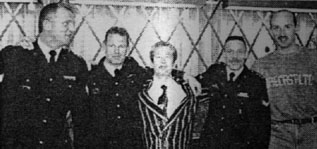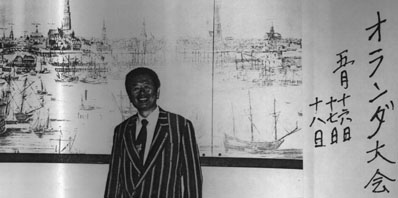 |
Pictures and Soke's Comments from the Netherlands TaiKai ( May 1996 )

 |
Pictures and Soke's Comments from the Netherlands TaiKai ( May 1996 )

1. Global Proverb
Holland, a.k.a. the Netherlands. Low lands embraced by the sea, where tulip fields and water windmills converse with the winds of Dover. There is a beautiful song called "April in Portugal" . . . I wonder if there is one called "May in the Netherlands"? The car runs on. We drive past the "Tower of Tears", where it is said that the wives and lovers of sailors setting out all over the world shed tears as they gathered to see them off. At the side we see the Daiel Jonas Meijer Plein, where a Dutch docker was shot for helping the Jews. The young authoress of "The Diary of Anne Frank" must have walked this area too. The flights of steps leading up to the entrance of each old-looking house are all of different heights. Apparently the higher the steps, the richer or more noble the person who lived there: the reason is the the space under the steps was where their servants would live.
We are invited to the Koninklijke Marine Kazerne Amsterdam, a Royal Marine base. "Today martial arts experts from the military and special units of the police are awaiting you, Sensei." We enter the base's training hall. A row of giant fighters. "Here in the Netherlands, Judo is quite popular isn't it? There is a wonderful Judoka called Geesink, who spoke of Judo from his heart. Let me tell you of a global view of Judo. Inside Japan there is a 'Judo proverb' stating that small people can throw large ones; but the global equivalent is that Judoka from a small country, the Netherlands, threw those of the large country, Japan. This is a 'proverb created by a spirit of respect and the true essence of the art'".

2. Amsterdam
The specialists in defending their country speak: "These combat techniques feel different -- but all of them are of the type we would need in a real situation." Apparently combat training here in the Netherlands takes place in realistic settings too. The Dutch are ranked quite high in the world for sports involving leg work, as I am sure you will agree if you look at Judo, football, bicycle racing or long distance skating.
We are invited to an Indonesian meal at a hall inside the base. As a souveneir I am presented with an item of Delft porcelain portraying De Amsterdam, a ship built in 1645 which still floats nearby in the harbour. It is marked "No. 18" -- apparently it is a limited edition and a very prestigious item, only given to those of Captain rank and moreover only those who are great heroes. The base's launch takes us from there to the town.
The red lights lure us to land. We stroll through the area of the film "The Woman in the Window", "Sensei, please conceal your camera," says a friend, a plain clothes policeman who was on the streets here for three years. As we look at the people walking around us, he says suddenly, "That one's suspicious. If I weren't here as your guide today I'd have nabbed him." Apparently there is a smell to criminals which he can sense and which guides him in to the target. The prostitutes deliver a broadside of smiles and winks to us through the show windows. Their high- leg costumes invite us in . . . but the hair carries the threat of a counterattack. I return their salute in the language of a healthy man's conditioned response, and walk on. Men suffer from a jinx in that they destroy themselves through drinking (alcohol), playing (gambling), and buying (women); but now there is another terrible one, drugs.

3. Taikai
Here we are at the Rood Licht. The owner presents it to us as the oldest brothel in this town of red lights. Near the ceiling hangs a puppet playing an accordion. When the switch is pressed he laughs and performs some jolly music. We sink a beer called Westmalle. Apparently this beer is made by the Trappist monks in Belgium. They say the monks never speak, but I wonder if their silence is golden or conceals something more sensual(1) . . . A friend tells us that in the Netherlands one could pick three people at random and find three differing views on politics, religion, or any other matter. It is in such cases that my one-to-one method of interaction with friends comes into its own.
The Bujinkan Netherlands Taikai starts, 500 male and female martial artists from 25 countries have gathered here. The theme for this year is "Ken / Tachi / Daito Shoto / Budo Taijutsu". We start with how to wear a sword, how to draw it, the Kamae, and move on to how a sword flows with the Kamae; and how footwork and the use(2) of the spine can give life both to the sword and to oneself and the partner. This training began at New Year 1996 using wooden swords. Five swords were broken the very first day. At the taikai Taikai too, as the first day began the participants were somewhat tense, yet at the same time in a festive mood. After a while I noticed that everyone had begun to train in a more relaxed manner, and called Richard to step forward, facing off(3) with Bokuto. Richard strikes in from Jodan. As his mighty sword descends I use a body change(4) and the power of intention to cut straight through it with my Bokuto, just at the point three inches from the tip. I cut through a wooden sword with a wooden sword. The five hundred people witnessing this incredible spectacle are dumbstruck. After a short pause Richard holds up the remants of his sword in both hands and says, "I will treasure this for the rest of my life".
____________________________________
(1) Westmalle in Japanese is pronounced "Best Mara", and Mara is a
religious / slang term for the demon between a man's legs . . .
(2) Written as "Essence of bravery"
(3) Mukaeru: normally "direct towards" but here written as "no Kamae"
(4) Taihen